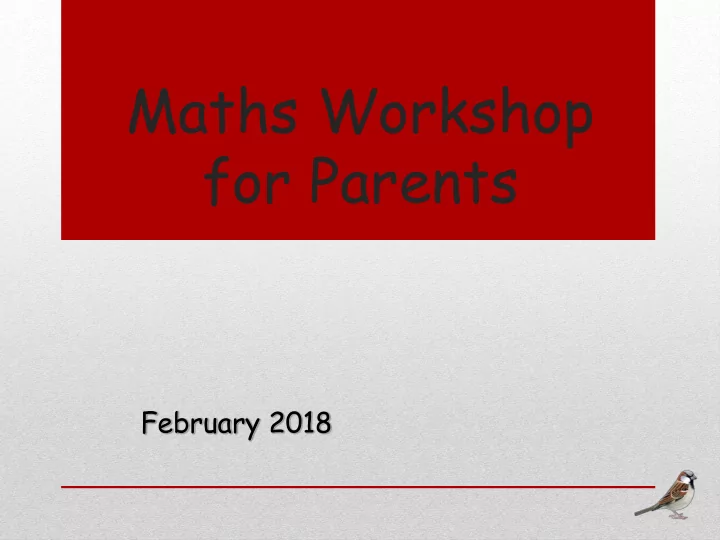

Maths Workshop for Parents February 2018
Aim The aim of today is to share the calculation methods we use at school so you are confident in supporting your child at home.
Developing Understanding • Prompting thinking & questioning • Providing opportunities to manipulate, experience and see (use of resources) • Develop thinking through investigation • Reasoning and making connections • Engaging in talk using mathematical vocabulary. • Encouraging children to make links and generalise
Reception and KS1 Mental Arithmetic The emphasis in Reception and KS1 is on mental arithmetic BUT based on practical activities using a range of equipment:
Resources
Working through calculations Concrete Pictorial Abstract Using objects Using drawings Using a written or jottings more formal method
Progression from Reception to Year 2 Addition ELG Count reliably from 1-20, place them in order. Say which number is one more than a given number Using quantities and objects, they add single-digit numbers and count on to find the answers
Year 1 - Addition Year 1 Expectations Count to and across 100, forwards beginning with 0 or 1, from any given number Given a number, identify one more Read, write and interpret mathematical statements involving addition (+), and equals (=) signs. Represent and use number bonds and related subtraction facts within 20 Add one-digit and two-digit numbers to 20, including zero Solve one-step problems that involve addition using concrete objects and pictorial representations, and missing number problems
Year 2 - Addition Year 2 Expectations Recall and use addition and subtraction facts to 20 fluently, and derive and use related facts to 100. Recognise and use the inverse relationship between addition and subtraction and use this to check calculations and solve missing number problems. Add numbers using concrete objects, pictorial representations, and mentally, including: A two-digit number and ones • A two-digit number and tens • Two two-digit numbers • Adding three one-digit numbers • Solve problems with addition including those involving numbers, quantities and measures.
Addition strategies Children are taught the rules of addition: Numbers can be added in any order The answer is always bigger then the numbers you are adding together
Addition strategies 20
Addition strategies
Addition strategies The column method is not introduced to children until Year 3.
Progression from Reception to Year 2 Subtraction ELG Say which number is one less than a given number. Using quantities and objects, they subtract two single-digit numbers and count back to find the answers
Year 1 - Subtraction Year 1 Expectations Say which number is one less than a given number Represent and use number bonds and related subtraction facts within 20 Read, write and interpret mathematical statements involving subtraction (-) and equals (=) signs Subtract one-digit and two-digit numbers to 20, including zero Solve one-step problems that involve subtraction using concrete objects and pictorial representations, and missing number problems.
Year 2 - Subtraction Year 2 Expectations Recall and use subtraction facts to 20 fluently, and derive and use related facts to 100. Recognise and use the inverse relationship between addition and subtraction and use this to check calculations and solve missing number problems. Subtract numbers using concrete objects, pictorial representations, and mentally, including: A two-digit number and ones • A two-digit number and tens • Two two-digit numbers •
Subtraction strategies Children are taught the rules of subtraction: The first number always has to go first The answer is always smaller then the numbers you are subtracting ‘Put 16 in your head and count back 4’
Subtraction strategies
Subtraction strategies
Subtraction strategies The column method is not introduced to children until Year 3.
Multiplication Multiplication - Early Years (EYFS) Children will continue to engage in a wide variety of songs and rhymes, games and activities. In practical activities and through discussion they will begin to solve problems involving doubling. Multiplication – Year 1 Solve one-step problems involving multiplication by calculating the answer using concrete objects, pictorial representations and arrays with the support of the teacher Count in multiples of twos, fives and tens Recall doubles of all numbers to at least 10
Multiplication and Division Multiplication – Year 2 Recall and use multiplication and division facts for the 2, 5 and 10 • multiplication tables Calculate mathematical statements for multiplication and division • Show that multiplication can be done in any order • Solve problems using multiplication and division •
How can you help at home? • Remain positive and be enthusiastic about maths • Point out the maths in everyday life. Include your child in activities involving maths such as using money, cooking and travelling. • Play simple maths games and help develop strong number knowledge • Number recognition, formation, counting forwards and backwards and in steps of 2, 3s (Year 2), 5s and 10s. • Number bond recal
Recommend
More recommend